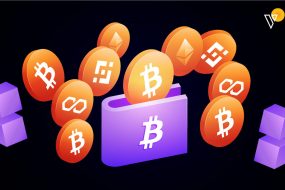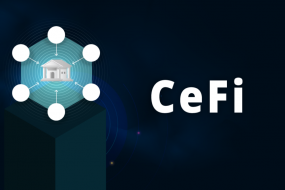
As digital assets continue gaining momentum, a new category of cryptocurrencies known as gold-backed coins has emerged. These novel projects aim to bring together the stability of gold and blockchain-based money’s portability. We are exploring how gold-backed cryptocurrencies work and shed light on their value proposition.
Gold-backed cryptocurrencies have emerged as a fascinating convergence of traditional finance and the digital revolution. In a world where digital assets are gaining traction, these cryptocurrencies offer a unique proposition – a digital representation of physical gold. This concept has sparked considerable interest among investors and enthusiasts alike, as it combines the time-tested allure of gold as a store of value with the innovation of blockchain technology.
In this article, we delve into the details of gold-backed cryptocurrencies, exploring how they work, what sets them apart, and the advantages they bring. These digital assets are backed by physical gold reserves held in secure custody, providing stability and security. Each token issued represents a specific amount of gold, creating a tangible link between the digital world and the physical precious metal.
We will investigate the mechanisms behind these cryptocurrencies, the issuance, redemption, and auditing processes, and their potential impact on the financial landscape. Understanding the intricate workings of gold-backed cryptocurrencies is crucial for anyone considering them as an investment or seeking to comprehend the evolving relationship between traditional assets and the blockchain. Whether you are an investor diversifying your portfolio or intrigued by the intersection of centuries-old financial assets and cutting-edge technology, this exploration will provide valuable insights into the world of gold-backed cryptocurrencies.
How Are They Backed? The Gold-Backed Cryptocurrencies
Unlike many other cryptos, gold-backed currencies maintain reserves of physical gold stored in secure vaults. For every coin created and circulated, an equivalent amount of gold is purchased and held. It gives each digital token intrinsic value tied directly to the market price of gold bullion. Blockchain audits verify reserve adequacy.
Gold-backed cryptocurrencies uniquely blend the traditional financial world and the digital realm. These digital assets derive their value from physical gold reserves held in custody. The gold backing ensures stability and security, making them an attractive option for investors seeking a stable store of value.
Each token typically represents a specific amount of physical gold, directly linking the digital currency and the precious metal. The gold backing is regularly audited to maintain transparency and trust. These cryptocurrencies offer a convenient way to invest in gold without the complexities of owning and storing physical bullion. This fusion of the age-old concept of gold as a reliable store of value with the innovation of blockchain technology has generated interest from investors and the financial industry.
Bridging Worlds
Gold-backed cryptocurrencies bridge traditional finance and the tokenized future by representing gold ownership using cryptocurrency frameworks. It appeals across generations by offering a familiar gold standard and the digitization advantages of cryptos, like fast global payments and fractional ownership. Transparency builds trust among both crypto natives and standard investors.
Smart Contract Functionality
Beyond essential value transfer, some projects leverage Ethereum intelligent contracts to unlock additional use cases. Features like borrowing against gold reserves with interest or staking coins for monthly allocation of reserve growth establish new earning models. This programmability expands the contour of what crypto and gold can achieve together.
Facilitating Acquisition
While gold has intrinsic worth, directly purchasing and securing the physical commodity presents logistic hurdles. Gold-backed cryptocurrencies simplify market entry by acting as a proxy investment. Users gain exposure without the challenges of transporting, assaying, or insuring hard assets themselves. This ease of access lowers barriers to participating in the gold economy digitally.
In conclusion, gold-backed cryptocurrencies represent an intriguing fusion that could appeal to traditionalists seeking a storied haven and technophiles drawn to emerging digital money forms. By blending existing strengths, they explore novel applications of the world’s longest-standing monetary asset for a new era of finance. Only time will tell how substantially the space develops, but initial ideas show promise.
What are some advantages of using gold-backed cryptocurrencies compared to traditional gold investments?
In a world where digital innovation continually transforms traditional financial landscapes, gold-backed cryptocurrencies have emerged as a compelling alternative to conventional gold investments. These digital assets offer many advantages over owning physical gold, providing investors with increased flexibility, accessibility, and security.
This introduction explores the key benefits of using gold-backed cryptocurrencies compared to traditional gold investments. These advantages include enhanced liquidity, fractional ownership, secure storage, global accessibility, reduced costs, faster transactions, and the introduction of innovative features. By understanding these benefits, investors, and enthusiasts can appreciate the unique value proposition offered by these digital assets, which combine the time-tested appeal of gold with the efficiency and versatility of blockchain technology.
Here are a few key advantages of gold-backed cryptocurrencies compared to traditional gold investments:
- Accessibility – Cryptocurrencies can be purchased and traded easily online from anywhere, 24/7, while physical gold requires storing and securing tangible assets.
- Divisibility – Digital gold-backed coins allow investing small amounts and paying with fractions of an ounce, unlike physical bullion, which typically needs to be purchased as whole ounces.
- Transaction Speed – Cryptocurrency transfers and payments are nearly instantaneous globally, faster than shipping gold between locations.
- Cost Effectiveness – Storing and insuring physical gold has overhead costs that third parties eliminate with digital asset ownership and storage.
- Payment Utility – Gold-backed coins function like a currency and can be used to directly pay for goods/services, unlike physical bullion, which is mainly an investment asset.
- Programmability – Some cryptocurrency projects allow earning interest, borrowing against reserves, etc., adding new flexible uses beyond static value storage.
- Tracking & Transparency – Blockchain audits provide complete visibility into reserve holdings buy/sell activity for each coin that isn’t available with traditional opaque gold products.
- Reserve Ratio – The proportion of gold held relative to coins issued varies by project, with 1:1 being the most conservative and backed entirely by physical bullion.
- Storage Facilities – Gold reserves are securely stored in facilities typically insured by companies like Brink’s and regularly audited/verified by independent 3rd parties.
- Pricing Link – In theory, the market price of each gold-backed coin should track very closely to the real-time price of the same amount of gold it represents.
- Supply Management – As demand fluctuates, many projects have mechanisms for efficiently creating/destroying coin supply while maintaining the gold reserve ratio.
- Exchange Listings – Major cryptocurrency exchanges sometimes list gold-backed projects, enhancing liquidity as an easy way for crypto traders to gain gold market exposure.
- Regulatory Stance – Gold is less controversial than other cryptos, but regulatory clarity still varies between treating gold coins like commodities or securities.
- Quality Variance – Projects have significant differences in areas like team experience/credibility, legal structures, audit standards, reserve transparency policies, etc.
- Use Case Evolution – New applications may emerge if development leverages crypto programmability or integrates with broader digital/decentralized finance platforms and services over time.
In summary, gold-backed cryptocurrencies streamline gold investment with modernized convenience, use cases, and accountability.
Trading Volume And Liquidity Of These Gold-Backed Cryptocurrencies
Trading Volume And Liquidity Are Essential Factors That Significantly Impact The Attractiveness And Functionality Of Gold-Backed Cryptocurrencies. The Ability To Buy And Sell These Digital Assets With Ease And Minimal Price Slippage Depends On The Depth Of The Market. Higher Trading Volume Indicates Greater Interest And Activity, Resulting In Enhanced Liquidity. In This Introduction, We’ll Delve Into The Dynamics Of Trading Volume And Liquidity In The Context Of Gold-Backed Cryptocurrencies. Understanding These Factors Is Crucial For Investors, As They Directly Influence The Ease Of Trading, Price Stability, And Overall Experience When Using These Digital Assets. We’ll Explore How These Elements Can Make Or Break The Practicality And Appeal Of Gold-Backed Cryptocurrencies In Investment And Everyday Transaction Contexts.
Here Are A Few Prominent Examples Of Gold-Backed Cryptocurrencies That Trade On Major Exchanges:
- Tether Gold (XAUT) – Backed 1:1 By The London Bullion Market Association, Good Delivery Gold Bars, Listed On Bitfinex, Okex, And Other Major Exchanges.
- PAX Gold (PAXG) – Issued By Paxos, Each Token Represents One Fine Troy Ounce Of London Good Delivery Gold Held By Brink’s, Listed On Binance And Other Top Exchanges.
- Digixdao (DGX) – Smart Contract Tokens Where Each Represents 1 Gram Of LBMA Gold Stored In The Delaware Depository, Traded Against DAI Stablecoin On Uniswap.
- Kinesis Money (KAG/KAU) – Allocated And Redeemable 1:1 With Physical Gold/Silver In Storage Facilities, Listed Against USD On Their Exchange.
- VELOCITY (Velocity) – Fully Gold-Collateralized Stablecoin Issued By Velocity Markets Can Be Traded Against USDT And ETH On Platforms Like Uniswap.
- Paycommerce (PYCN) – Each Token Represents 0.1 Troy Ounces Of Gold, Traded Against USDT And BTC On The Stex Exchange And P2P On Their Platform.
These Projects Demonstrate How Significant Players And Startups Are Innovating To Let Cryptocurrency Traders Quickly Gain Exposure To Gold Markets Through Decentralized, Digitized Assets.
Conclusion
Delving into the intricacies of gold-backed cryptocurrencies reveals a fascinating intersection of traditional finance and cutting-edge blockchain technology. These digital assets, tethered to the enduring value of physical gold, represent an innovative solution to the age-old desire for a stable store of value. Understanding the fundamental workings of gold-backed cryptocurrencies, from the issuance and redemption processes to the secure custody and auditing of gold reserves, is essential in grasping their significance in the modern financial landscape.
Gold-backed cryptocurrencies offer a new dimension of liquidity, accessibility, and security previously unattainable with physical gold. Their fractional ownership options, cost-effectiveness, and global accessibility make them a viable choice for investors looking to diversify their portfolios and reduce barriers to entry.
As the world of finance continues to evolve, these digital assets contribute to the ongoing dialogue surrounding the relationship between traditional assets and the blockchain. Whether one seeks to invest in precious metals or explore the ever-expanding world of cryptocurrencies, understanding gold-backed tokens is crucial. They represent a bridge between the time-tested allure of gold and the transformative potential of decentralized digital currencies, and their role in the financial landscape is poised to grow in the coming years.











